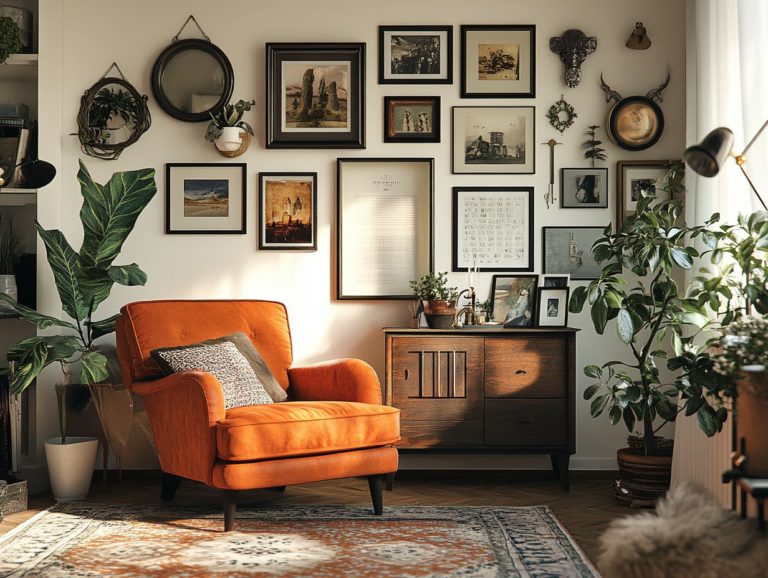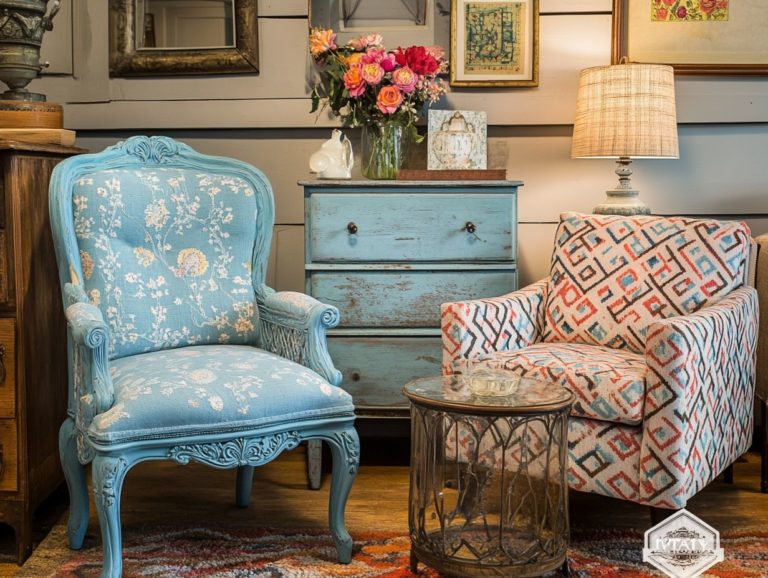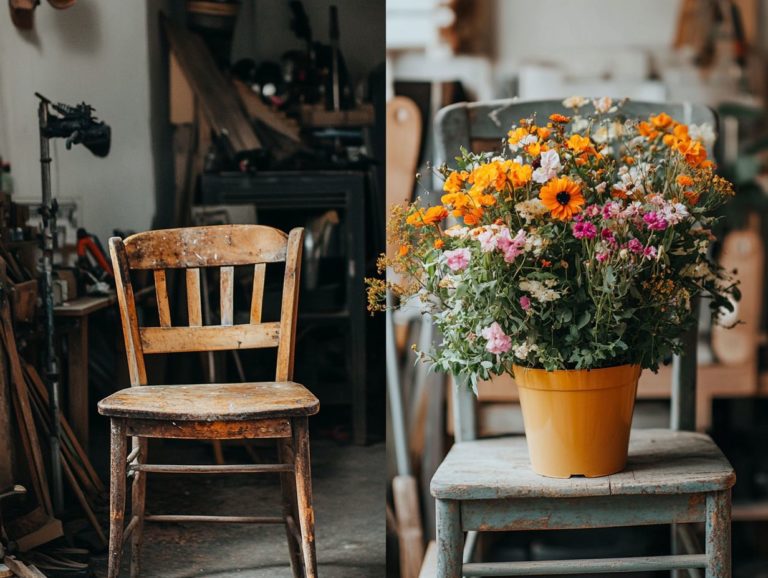The Basics of Vintage Furniture Restoration
Vintage furniture restoration transcends mere trends; it invites you on a journey of preserving history while infusing your space with a personal touch.
This article delves into the myriad benefits of restoring vintage pieces, from maintaining their unique charm to transforming them into something that truly reflects your style.
Get ready to uncover the essential tools you’ll need for the task at hand, along with a step-by-step guide to navigate the restoration process. Plus, you ll find valuable tips for keeping your beautifully revived furniture in pristine condition.
Whether you re a seasoned restorer or just starting to explore this fascinating craft, dive in now to uncover insights that will spark your passion for vintage treasures.
Contents
Key Takeaways:
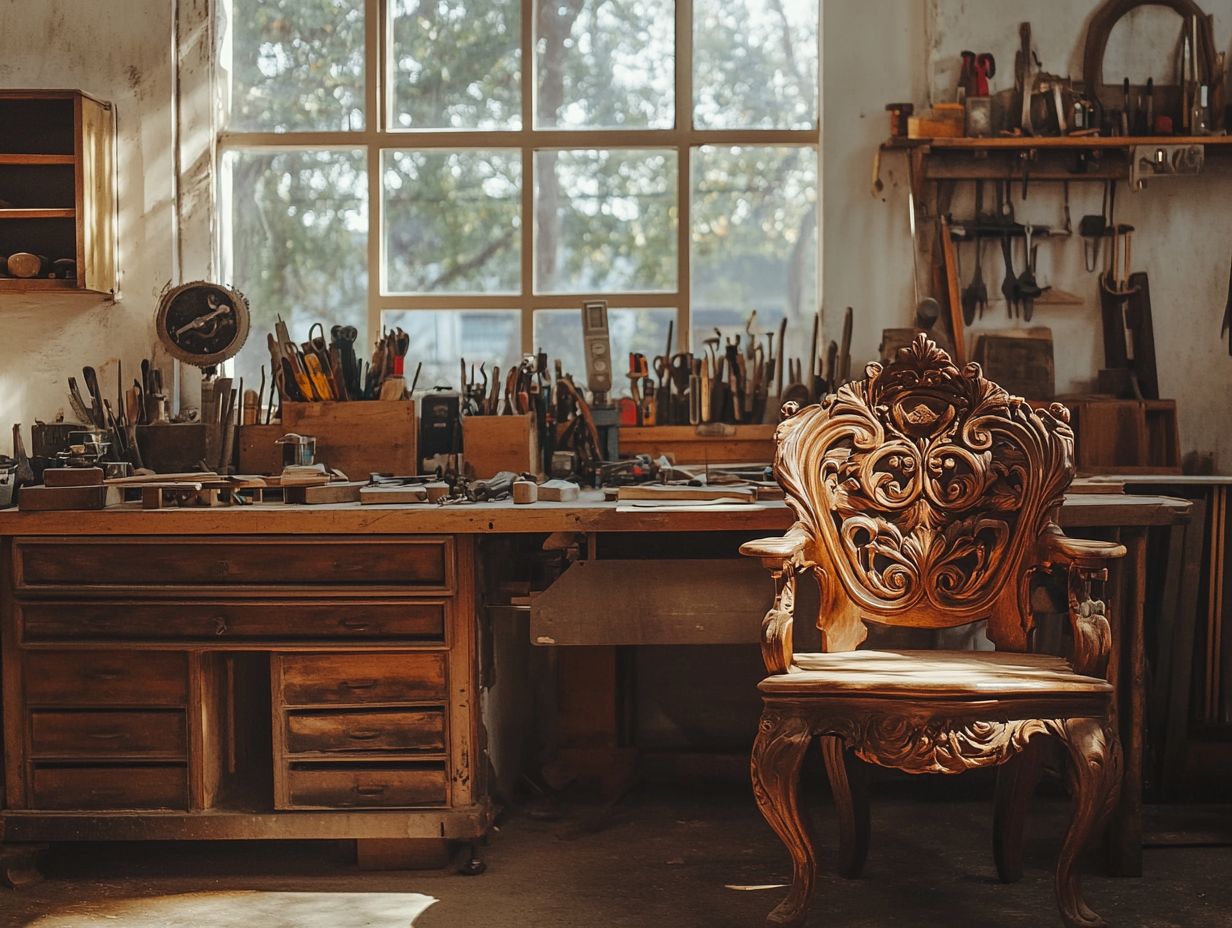
- Restoring vintage furniture preserves history and adds a personal touch to your home decor.
- Essential tools and supplies include sandpaper, wood glue, and a quality finish for a successful restoration.
- Proper preparation, cleaning, and repair techniques are crucial for achieving a professional finish on restored vintage furniture.
What is Vintage Furniture Restoration?
Vintage furniture restoration is a creative project that allows you to breathe new life into old pieces. It celebrates their unique history and heritage while seamlessly integrating modern techniques to enhance both their aesthetic appeal and functionality.
This craft not only revives the charm of antique designs but also invites you to express your creativity. By mastering the nuances of refinishing (which means sanding and polishing wood surfaces), painting, and staining, you can effectively restore cherished furniture and give those treasured items the revival they so richly deserve.
The significance of vintage furniture restoration goes far beyond surface beauty; it cultivates a profound emotional connection to the past. Each piece carries a story, holding memories and experiences that enrich the atmosphere of your home. To enhance your restoration projects, consider using the best vintage furniture restoration supplies.
Preserving these items honors their craftsmanship while safeguarding a slice of history, creating a timeless bridge between generations. Techniques like upholstery repair (fixing the fabric of furniture), refinishing, and structural reinforcement not only bolster durability but also uphold the integrity of vintage designs.
These restored treasures can also appreciate in value, transforming them into not just sentimental keepsakes but wise investments. In an age of eco-conscious living, restoring vintage furniture aligns perfectly with sustainability. This practice reclaims and refurbishes old furniture, reducing waste and lessening the demand for new resources.
Benefits of Restoring Vintage Furniture
Restoring vintage furniture presents a wealth of advantages, elevating the aesthetic charm of your home while embodying a cost-effective and eco-conscious approach to refurbishing your space.
By opting for refurbishment over replacement, you embrace a sustainable practice that significantly contributes to waste reduction and environmental preservation.
The restoration journey cultivates a sense of community and personal connection. It allows you to breathe new life into furniture pieces that carry rich stories and cherished memories from the past, which are definitely worth saving.
Preserving History and Personalization
Preserving history through vintage furniture restoration offers you a unique opportunity to connect with your heritage while adding a personal touch to your living spaces. Each restored piece carries its own story, representing a distinct chapter in time that deepens your appreciation for the craft and its significance.
By embracing restoration, you honor the past while seamlessly infusing contemporary designs that reflect your individual style and creativity. This approach not only enriches your home but also fosters a sense of community among those who share your passion for historical significance.
Engaging in this process opens the door to conversations about craftsmanship, family traditions, and local artisans, strengthening the ties that bind you to your roots.
Vintage furniture acts as a tangible link to previous eras, allowing you to celebrate your lineage while showcasing your personal aesthetic. As you curate your spaces, you invoke memories and stories, transforming furniture into cherished heirlooms that resonate with emotion and purpose.
Ready to start your restoration journey? Let’s dive in!
Tools and Materials Needed for Restoration
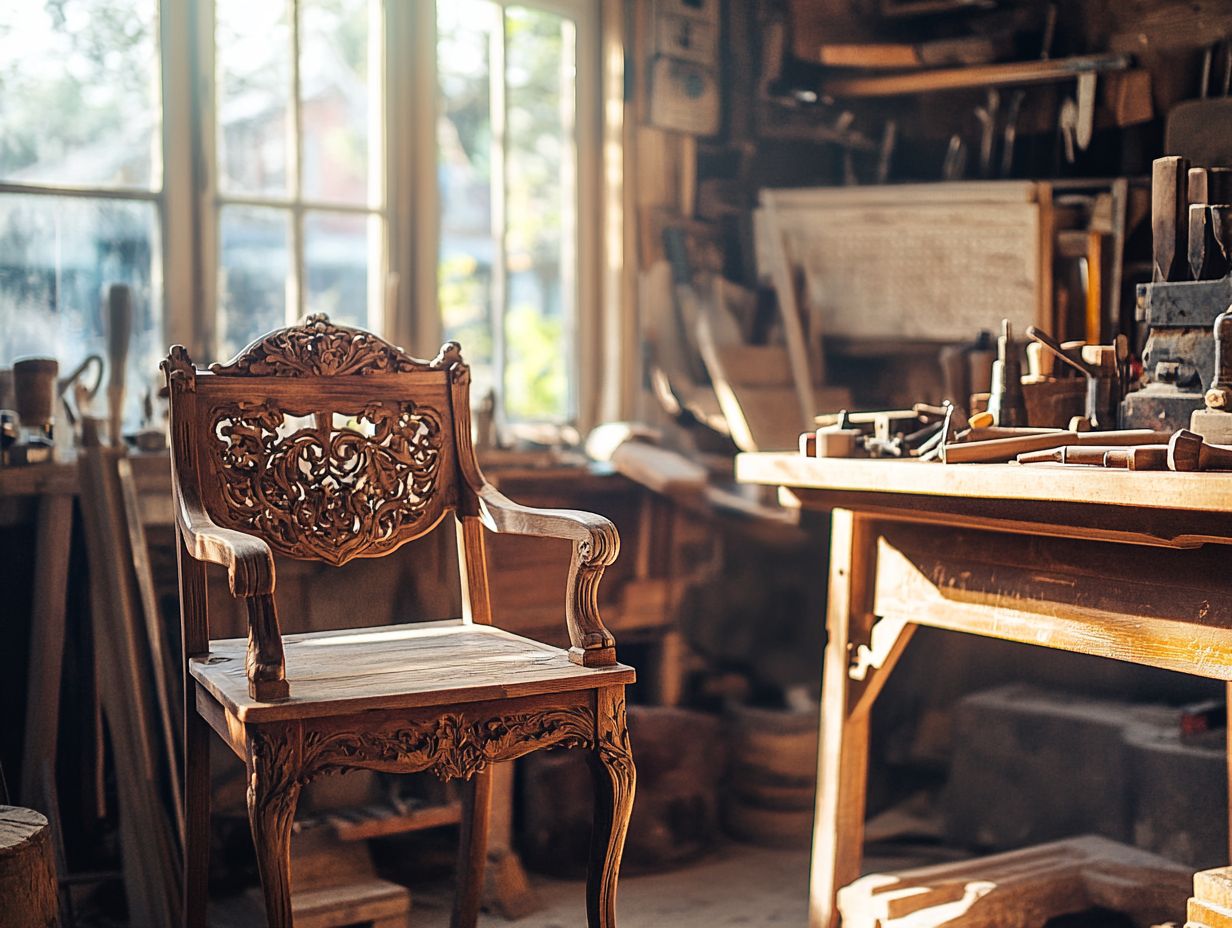
Having the right tools makes all the difference in navigating the intricate process of vintage furniture restoration. A well-equipped workspace not only enhances your skills but also ensures safety throughout your restoration journey.
Understanding the necessary tools from sanding and painting to using substances used to remove old paint or finishes and heat guns for repairs is crucial. This knowledge will help you achieve optimal results while minimizing health risks associated with dust and chemicals.
Essential Supplies and Equipment
Essential supplies and equipment are vital for your vintage furniture restoration project. They provide the foundation needed for professional-quality results. Key items like paintbrushes, sandpaper, and sealants enable you to execute various techniques, such as painting, staining, and refinishing, with finesse.
Investing in high-quality tools will significantly enhance both the efficiency and outcomes of your restoration endeavors.
To ensure a smooth restoration experience and maintain organization, consider keeping the following essential items on hand:
- Wood glue for structural repairs
- Microfiber cloths for cleaning and dusting
- A selection of clamps to hold pieces together while they dry
When choosing these tools, seek out reputable brands synonymous with durability and effectiveness. A high-quality synthetic bristle brush will help you achieve a smoother finish compared to cheaper counterparts.
Choose sandpaper with different grits for more options. Always select non-toxic finishes to safeguard both the furniture and yourself.
By incorporating these carefully selected supplies, you streamline the restoration process and create long-lasting, stunning pieces that you’ll be proud to showcase in your home.
Step-by-Step Guide to Restoring Vintage Furniture
A comprehensive step-by-step guide to restoring vintage furniture enables you to master essential techniques and processes. This knowledge is key to breathing new life into old furniture pieces.
Each stage, from preparation and cleaning to repair and refinishing, is vital for ensuring a successful restoration. It elevates the piece’s aesthetic while preserving its integrity and value making it a worthwhile investment.
By following this guide, you will gain valuable insights into effective methods and best practices, allowing you to transform your vintage furniture into stunning centerpieces that enhance your home.
Preparation and Cleaning
Preparation and cleaning are essential first steps in your vintage furniture restoration journey. These steps lay the groundwork for successful refinishing and repair.
Carefully check your furniture’s condition and use cleaning techniques tailored to the specific materials. This will help you eliminate dust, dirt, and any old finishes that might hinder the restoration process.
This thorough preparation ensures surfaces are primed for sanding, painting, or staining, ultimately improving the final outcome of your project.
Employing methods like gentle soap and water solutions for wood surfaces can work wonders. For more delicate finishes, such as lacquer or varnish, specialized cleaners may be necessary. For upholstered pieces, a thorough vacuuming followed by a fabric-safe cleaner will help restore their original charm without compromising the material.
To maintain the integrity of antique wood, applying a mixture of mineral spirits and boiled linseed oil can beautifully revive its luster. These meticulous techniques not only clean but also prepare your furniture for further enhancements, ensuring a stunning revival that pays homage to its rich history.
Now that you re equipped with the right tools and knowledge, let s dive into the exciting world of vintage furniture restoration!
Repair and Refinishing Techniques
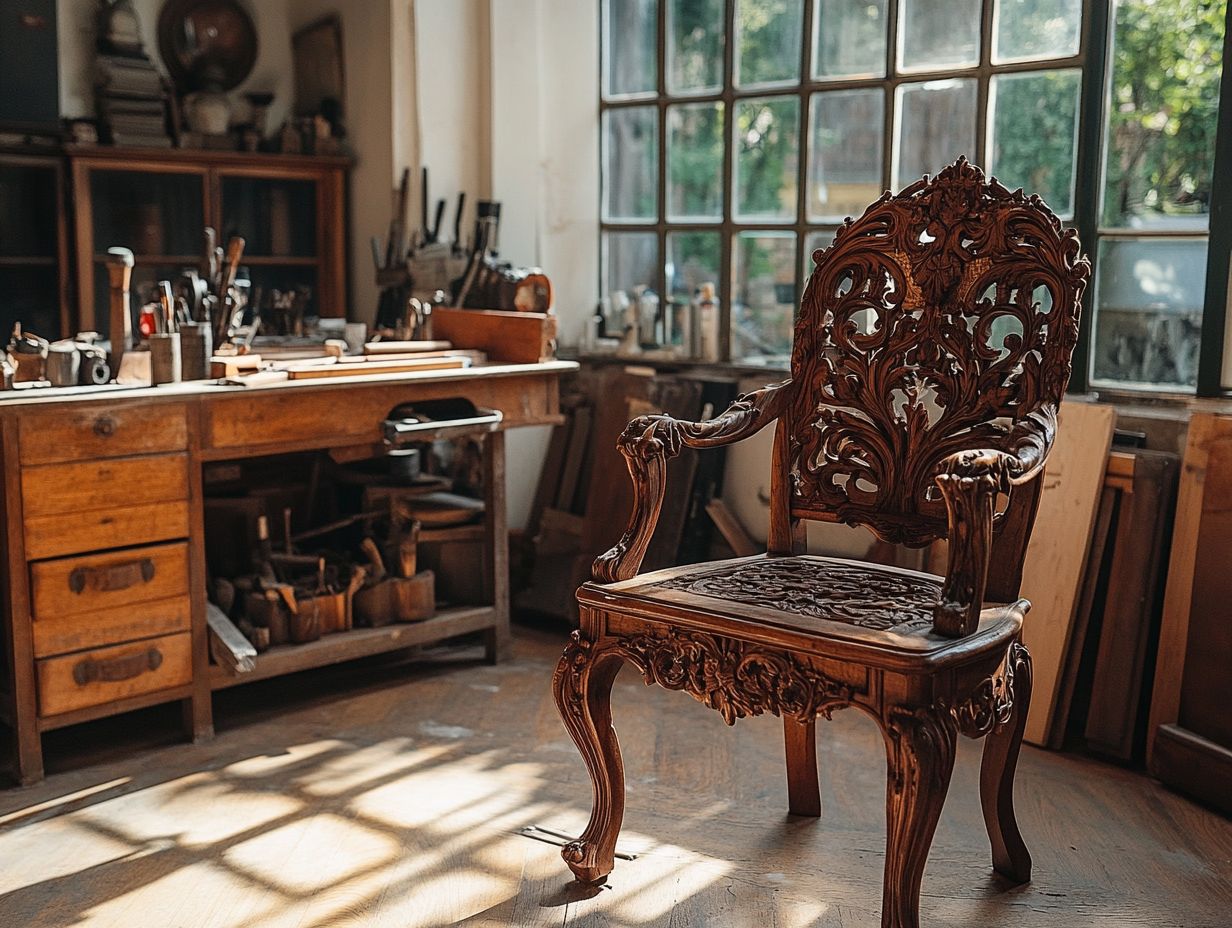
Mastering repair and refinishing techniques is crucial for achieving a professional-quality finish in your vintage furniture restoration projects. Techniques like sanding, using chemical strippers, and employing heat guns effectively address imperfections and prepare surfaces for painting or staining.
By understanding various wood types and their characteristics, you ll be able to select the most suitable refinishing methods. This ensures that the integrity of the furniture is preserved while enhancing its overall beauty.
In vintage furniture restoration, paying attention to the nuances of each repair technique is just as important. When sanding, always move with the grain to avoid unsightly scratches, and vary the grits to gradually smooth out surfaces before applying a finish.
Chemical strippers are a valuable alternative for delicate pieces that need a gentle touch. Meanwhile, using heat guns requires you to maintain a consistent distance from the surface to prevent damage.
Ensure your workspace is well-ventilated and use appropriate protective gear to stay safe as you immerse yourself in the enchanting craft of rejuvenating old treasures.
Tips for Maintaining Restored Vintage Furniture
Maintaining restored vintage furniture requires a considerate approach to care and preservation. This ensures that the effort invested in furniture restoration is protected for years to come. Regular cleaning and careful handling are crucial to safeguarding the integrity and beauty of these pieces. Additionally, the right environmental conditions play a vital role in preserving their finish and structure.
By following a few simple tips, you can ensure that your vintage treasures remain stunning and functional for generations to enjoy.
Proper Care and Preservation
Caring for vintage furniture is essential. It helps maintain beauty and functionality over time. By using good cleaning methods, monitoring environmental conditions, and applying protective finishes, you can dramatically extend the lifespan of your cherished pieces.
Understanding the specific needs of different wood types and finishes allows you to customize your care routine. This ensures that your vintage furniture remains a treasured part of your home for decades to come.
Adjusting humidity levels in your living space can help prevent warping or cracking, particularly important for older woods. Use a soft, lint-free cloth for regular dusting to keep surfaces free from damaging debris. Avoid harsh chemicals to protect the original finish.
Exploring suitable waxes or oils can offer an added layer of protection and restore that coveted luster, enhancing the visual appeal of your vintage furniture. Placing your pieces strategically away from direct sunlight can mitigate fading, preserving their integrity over the years.
Frequently Asked Questions
What is vintage furniture restoration?

Furniture restoration is the process of repairing, cleaning, and refinishing antique or older pieces of furniture to restore them to their original condition.
Why should I restore vintage furniture?
Restoring vintage furniture can bring new life to a piece that may otherwise be discarded due to its condition. It also helps preserve the history and character of the piece.
What are the basic steps of vintage furniture restoration?
The basic steps of vintage furniture restoration include assessing the condition of the piece, cleaning and repairing any damage, sanding and refinishing the wood, and replacing any missing hardware or parts.
What tools and materials do I need for vintage furniture restoration?
For basic vintage furniture restoration, you will need sandpaper, wood filler, paint or stain, a paintbrush or foam brush, and a cloth for cleaning. Depending on the specific piece, you may also need additional tools or materials.
Don’t wait! Start your restoration project today and share your experiences with others who appreciate the beauty of vintage furniture.
Can I restore vintage furniture on my own?
Yes, you can restore vintage furniture on your own if you have the right tools and skills. If you re unsure about a complex piece, ask a pro for help.
How do I maintain restored vintage furniture?
Keep your vintage piece looking fabulous with regular dusting and cleaning! Avoid placing it in direct sunlight and away from heat sources. Always check for signs of damage or wear to prevent further issues.

